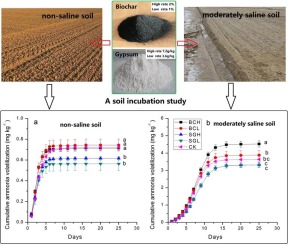Catena ( IF 6.2 ) Pub Date : 2020-02-25 , DOI: 10.1016/j.catena.2020.104527 Hai Zhu , Jingsong Yang , Rongjiang Yao , Xiangping Wang , Wenping Xie , Wei Zhu , Xiaoyuan Liu , Yifan Cao , Jianyu Tao

|
Ammonia (NH3) volatilization is a major route of nitrogen (N) loss from soil, especially in saline soil. Biochar and gypsum are two important soil amendments that are widely used in coastal saline farmland. However, little is known about the interactive effects of soil amendments and salinity on NH3 volatilization. In this study, five soil salinity levels, three N sources (urea, monoammonium phosphate (MAP), and manure) and two soil amendments (biochar and gypsum, both applied at two rates) were selected to conduct incubation experiments. Nitrogen transformation experiments were conducted simultaneously with NH3 volatilization experiments. The results showed that cumulative NH3 volatilization increased with salinity due to the accumulation of ammonium, which resulted from the inhibition of nitrification by salinity, and also the effect of salinity on soil properties related to NH3 volatilization. Among the tested N sources, the highest NH3 volatilization was observed for urea, followed by MAP and manure, in soils with three different salinity levels. Biochar application increased NH3 volatilization in saline soil, as salt ions constrained the NH3/ NH4+ adsorption capacity of biochar, and the inhibition of nitrification by biochar was aggravated in saline soil. Overall, NH3 volatilization increased with the biochar application rate in saline soil, whereas the effect of a low rate of biochar application on NH3 volatilization was not significant. Gypsum decreased NH3 volatilization in saline soil, whereas the contribution of different gypsum rates to NH3 volatilization showed no difference. The conclusion could be drawn from the above results that low rates of biochar and gypsum may prevent or reduce NH3 volatilization and nitrogen losses in coastal saline soil.
中文翻译:

土壤改良剂(生物炭和石膏)和盐分对沿海盐渍土壤氨挥发的相互作用
氨(NH 3)挥发是土壤中氮(N)损失的主要途径,尤其是在盐渍土壤中。生物炭和石膏是在沿海盐碱农田中广泛使用的两种重要的土壤改良剂。但是,关于土壤改良剂和盐分对NH 3挥发的相互作用的影响知之甚少。在这项研究中,选择了五个土壤盐度水平,三个氮源(尿素,磷酸一铵(MAP)和肥料)和两个土壤改良剂(生物炭和石膏,均以两种比率施用)进行培养实验。氮转化实验与NH 3挥发实验同时进行。结果表明,累积NH 3由于盐分对硝化作用的抑制作用,以及铵盐对土壤中与NH 3挥发有关的特性的影响,铵盐的积累导致铵盐的挥发作用随盐分的增加而增加。在测试的氮源中,在三种不同盐度水平的土壤中,尿素的NH 3挥发最高,其次是MAP和肥料。施用生物碳增加了盐土中NH 3的挥发,因为盐离子限制了生物碳的NH 3 / NH 4 +吸附能力,并且在盐土中加重了生物碳对硝化的抑制作用。总体而言,NH 3盐渍土壤中生物炭的施用量增加了挥发量,而较低的生物炭施用量对NH 3挥发的影响不明显。石膏减少了盐渍土壤中NH 3的挥发,而不同石膏速率对NH 3挥发的贡献没有差异。从以上结果可以得出结论,低生物炭和石膏的比例可以防止或减少沿海盐渍土壤中的NH 3挥发和氮损失。


























 京公网安备 11010802027423号
京公网安备 11010802027423号